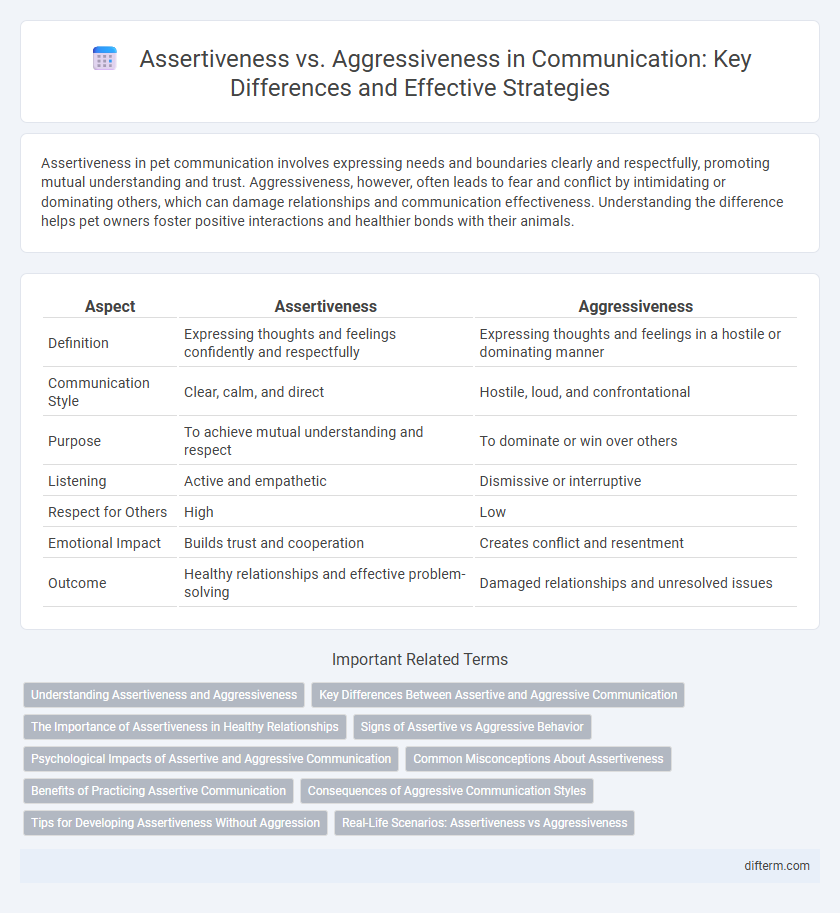Assertiveness in pet communication involves expressing needs and boundaries clearly and respectfully, promoting mutual understanding and trust. Aggressiveness, however, often leads to fear and conflict by intimidating or dominating others, which can damage relationships and communication effectiveness. Understanding the difference helps pet owners foster positive interactions and healthier bonds with their animals.
Table of Comparison
| Aspect | Assertiveness | Aggressiveness |
|---|---|---|
| Definition | Expressing thoughts and feelings confidently and respectfully | Expressing thoughts and feelings in a hostile or dominating manner |
| Communication Style | Clear, calm, and direct | Hostile, loud, and confrontational |
| Purpose | To achieve mutual understanding and respect | To dominate or win over others |
| Listening | Active and empathetic | Dismissive or interruptive |
| Respect for Others | High | Low |
| Emotional Impact | Builds trust and cooperation | Creates conflict and resentment |
| Outcome | Healthy relationships and effective problem-solving | Damaged relationships and unresolved issues |
Understanding Assertiveness and Aggressiveness
Assertiveness involves confidently expressing thoughts and needs while respecting others, promoting clear and effective communication. Aggressiveness disregards others' feelings and rights, often leading to conflict and misunderstanding. Developing assertiveness enhances interpersonal relationships by balancing self-expression with empathy.
Key Differences Between Assertive and Aggressive Communication
Assertive communication respects both one's own rights and the rights of others through clear, honest, and respectful expression, while aggressive communication disregards others' feelings and rights by using forceful, hostile, or dominating language. Key differences include tone, intent, and outcome; assertiveness fosters mutual understanding and problem-solving, whereas aggressiveness often leads to conflict and resentment. Understanding these distinctions enhances effective interpersonal interactions and conflict resolution skills.
The Importance of Assertiveness in Healthy Relationships
Assertiveness fosters clear, respectful communication by expressing needs and boundaries without violating others' rights, which is essential for building trust and mutual respect in healthy relationships. Unlike aggressiveness, which often leads to conflict and resentment, assertiveness encourages open dialogue and emotional safety. Practicing assertiveness enhances problem-solving and strengthens connection, contributing to long-term relational satisfaction and well-being.
Signs of Assertive vs Aggressive Behavior
Assertive behavior is characterized by clear, direct communication, maintaining respectful eye contact, and expressing needs calmly without infringing on others' rights. Aggressive behavior often involves raised voices, interruptions, hostile body language, and a disregard for others' feelings or opinions. Recognizing these signs helps foster healthier interpersonal interactions and effective conflict resolution.
Psychological Impacts of Assertive and Aggressive Communication
Assertive communication promotes psychological well-being by fostering self-confidence, reducing stress, and enhancing interpersonal relationships through respectful expression of thoughts and feelings. Aggressive communication often leads to increased anxiety, damaged relationships, and diminished self-esteem due to hostile or confrontational interactions. Understanding these psychological impacts supports healthier communication patterns and emotional resilience.
Common Misconceptions About Assertiveness
Common misconceptions about assertiveness often confuse it with aggressiveness, leading many to believe assertive communication is confrontational or rude. Assertiveness involves expressing opinions and needs respectfully while maintaining others' rights, contrasting with aggressiveness that disregards others' feelings or boundaries. Understanding this distinction improves interpersonal communication by promoting clarity and mutual respect without hostility.
Benefits of Practicing Assertive Communication
Practicing assertive communication enhances clarity and mutual respect, fostering stronger interpersonal relationships and reducing conflict. It empowers individuals to express their thoughts and needs confidently without infringing on others' rights, improving collaboration and problem-solving. This communication style promotes emotional intelligence and self-confidence, contributing to healthier workplace and personal environments.
Consequences of Aggressive Communication Styles
Aggressive communication often leads to damaged relationships and heightened conflict, as it disregards others' feelings and perspectives. This communication style can result in increased stress, reduced cooperation, and a hostile environment both in personal and professional settings. Long-term consequences include loss of trust, isolation, and impaired teamwork, negatively impacting overall communication effectiveness.
Tips for Developing Assertiveness Without Aggression
Developing assertiveness without aggression involves clear, direct communication while respecting others' boundaries and feelings. Practicing active listening, using "I" statements to express thoughts and emotions, and maintaining a calm tone enhances assertive expression without provoking conflict. Setting firm, respectful boundaries and rehearsing responses in challenging situations also reinforces confidence and prevents aggressive tendencies.
Real-Life Scenarios: Assertiveness vs Aggressiveness
In workplace meetings, assertiveness enables clear expression of ideas while respecting others' viewpoints, fostering collaboration and problem-solving. Aggressiveness in the same setting often leads to conflicts, as it disregards colleagues' opinions and creates a hostile environment. Real-life scenarios demonstrate that assertiveness builds trust and rapport, essential for effective communication and team success.
assertiveness vs aggressiveness Infographic

 difterm.com
difterm.com